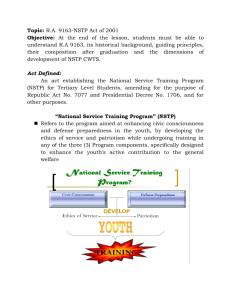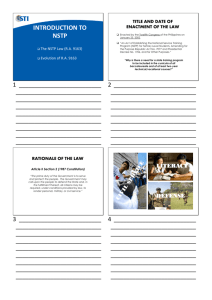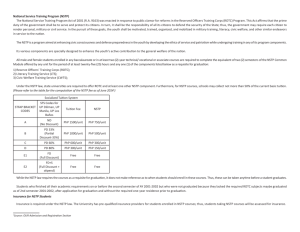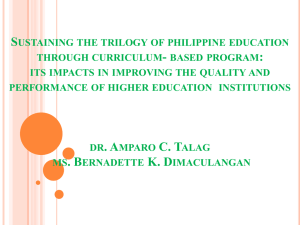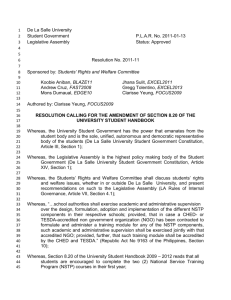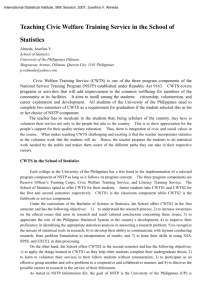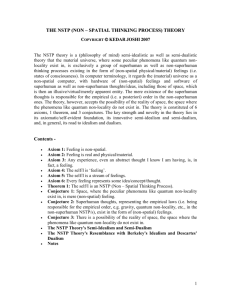The Effects of NSTP on the Lives of Saint Louis University
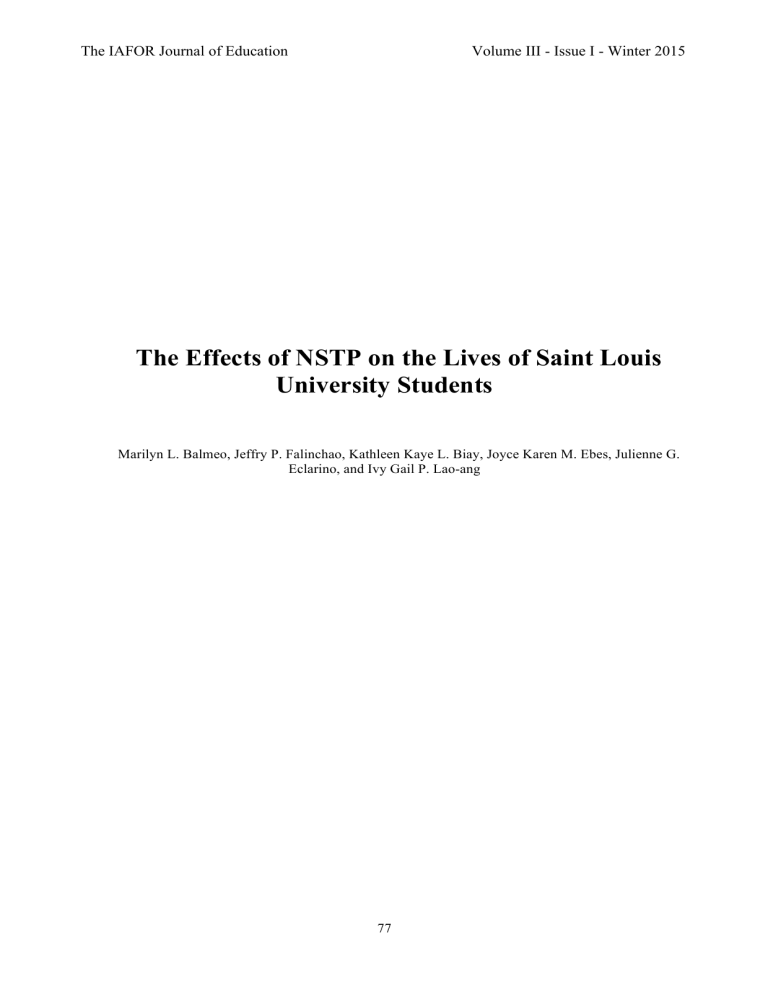
The IAFOR Journal of Education Volume III - Issue I - Winter 2015
The Effects of NSTP on the Lives of Saint Louis
University Students
Marilyn L. Balmeo, Jeffry P. Falinchao, Kathleen Kaye L. Biay, Joyce Karen M. Ebes, Julienne G.
Eclarino, and Ivy Gail P. Lao-ang
77
The IAFOR Journal of Education Volume III - Issue I - Winter 2015
Abstract
The National Service Training Program (NSTP) of the Philippines is a form of service learning which is defined as the integration of community services to instruction in order to strengthen the civic and community responsibilities of the students. The purpose of this study is to determine the effectiveness of the NSTP for the students, its influences along self-improvement, performance, community involvement, and demonstration of abilities and skills, and the difficulties encountered by the students while enrolled in their respective NSTP courses. The 1421 respondents of the study were the undergraduate students of Saint Louis University who finished the NSTP courses last school year 2012-2013. The study utilized an adapted survey-type questionnaire to gather the data needed in the study. The findings of the study suggest that NSTP courses are effective and they influenced the self-improvement, performance, community involvement, and demonstration of abilities and skills of the students to an extent. The students are also able to continue to demonstrate the different competencies they learned or acquired from
NSTP courses. Moreover, this study reveals that the students often encountered many difficulties while they were enrolled in the NSTP courses.
Keywords: NSTP; service learning; community services; self-improvement; performance; community involvement; competencies; difficulties.
78
The IAFOR Journal of Education Volume III - Issue I - Winter 2015
Introduction
National service does not simply mean "serving the public"; it means serving the public under particular political and economic institutions; it means serving the nation in an age of nationalism; and it means constructing the nationalism which it serves (Gorham, 1992). It is practiced in many countries all around the globe. These national services may be in the form of military, nonmilitary services, non-military compulsory programs, and some even integrated in the educational system like in the Philippines in the form of the National Service Training Program (NSTP).
These kinds of national services, which are integrated with the respective educational systems of each country, are forms of service-learning. Service-learning may be defined as an approach integrating community services with instruction to apply what students have learned inside the classroom to the real world context in order to concretize learning and to strengthen civic and community responsibilities. Service learning is about hands-on participation in community-based projects. Based on Edgar Dale's Cone of Experience, the most effective methods involve
d irect, purposeful learning experiences, such as hands-on or field experiences (Anderson, n. d.). This emphasizes that learning from experience has a greater influence or impact on the lives of the students.
There are some studies conducted in other countries about the impacts of service learning to the students. The findings of these studies revealed that the impacts may be observed on their academic, civic or citizenship, and social or personal aspects. Furco's study (2002) showed that the service-learning group scored higher on all academic measures though the only statistically significant differences were between the service-learning and the no service group. National
Service Knowledge Network (n. d.), revealed that the students who participated in the servicelearning were found to be more cognitively engaged and more motivated to learn. In cognitive domains, training improves the quality of thinking and it involves problem solving, decision making, and explanation to achieve goals [Asia-Pacific Institute for Broadcasting Development
(AIBD), 2012]. Studies show great promise for service-learning as an avenue for increasing achievement among alternative school students and other students considered at risk of school failure.
Morgan and Streb's study (2001) demonstrated that service-learning projects with student leadership can help make students better citizens. Furthermore, as stated in the research conducted by Ammon, et al. (2001), the differences in impact were attributed to differences in programmatic goals; disparity in the ways in which attitudes changed; the ways in which previous service experiences were linked to civic engagement; and the differences in student thinking about good citizenship. A theory that will support this is the Gestalt theory which stimulates learning as experience and the experience as a source of learning (Lucas & Corpuz, 2011) because the argument of Ammon, et al. (2001) regarding the impact of service learning to the students discussed about the experiential learning of the students and how they learned from their experiences of service learning. Lastly, the authors of the study on the impacts on transition to adulthood (Martin, Neal, Kielsmeier, & Crossley, 2006), found that when compared to young people who were involved in service-only experiences, students who took part in service-learning reported more positive effects in their ability to help others, work well with other people, respect others, and see the world from other perspectives. Service-learning participants noted increased skills in communication, a heightened sense of self-confidence, and more sensitivity to differences in age, race, and economic status.
The NSTP (LAWPH i L, 2002) is a service rendered to one’s own country with its aim of enhancing civic consciousness and defense preparedness in the youth by developing the ethics of service and patriotism while undergoing training in any of its three (3) program components in the Philippines. The following are the components of NSTP which are specially designed to enhance the youth's active contribution to the general welfare according to the Philippine
79
The IAFOR Journal of Education Volume III - Issue I - Winter 2015
Republic Act No. 9163: (a) Reserve Officers' Training Corps (ROTC); (b) Civic Welfare
Training Service (CWTS); and (c) Literacy Training Service (LTS). In Saint Louis University
(SLU) where this study was conducted, CWTS and LTS were chosen to be part of NSTP based on the survey conducted in SLU to be part of NSTP; and because the two are very related to the nature of the school activities such as environmental and solid waste management, energy saving, medical and health missions, data processing, cultural presentation, research or survey, fitness and wellness are some to mention.
After ten years of its implementation in SLU, NSTP has already undergone a long journey. Hence, this study aimed to determine the effect of NSTP to the development of the students. It specifically sought to answer the following questions: (1) How effective were the NSTP courses for the Saint Louis University students? (2) What influences did NSTP courses provide the students along: (a) self-improvement; (b) performance; (c) community involvement; and (d) demonstration of competencies; and (3) What were the difficulties encountered by the students while enrolled in NSTP courses?
The theories that were used in this study are Transformative Learning theory and Dewey's
Principle of Continuity. Mezirow's transformative learning theory focuses on how people make meaning of their experiences and, in particular, how significant learning and behavioral change often result from the way people make sense of ill structured problems, critical incidents, and/or ambiguous life events (Kiely, 2005). This theory is used to explain the impact of students' participation in community service programs in their holistic learning and development.
John
Dewey's Philosophy of Experience and Education presented the principle of continuity. The principle of continuity states, "delete all experiences are carried forward and influence future experiences," [International Centre for Educators’ Learning Styles (ICELS), 2013]. Thus, this will tell that the learners who completed the NSTP courses will continue to apply and empower what they had learned from NSTP courses in their future activities.
The study is significant to the SLU-NSTP because it will help in evaluating whether the activities or service trainings they implement are molding the SLU students to be more competent, more creative, living by the Christian spirit, and more socially involved citizens of the country. The proposed study will also help the teachers, especially those teaching NSTP to make the learning of the students more experiential and stay with them for a long period.
Methodology
This study is a descriptive-survey type of research. According to Calmorin and Calmorin 5 (2010), this type is suitable wherever the subjects vary among themselves and one is interested to know the extent to which different conditions and situations are obtained among these subjects.
Particularly, the focus of the study is to determine the influence of NSTP activities to the holistic development of undergraduate students of Saint Louis University and the difficulties they encountered while enrolled in both courses of NSTP.
The respondent of this study were the undergraduate students per school of Saint Louis
University, specifically from School of Accountancy and Business Management (SABM), School of Computing and Information Sciences (SCIS), School of Engineering and Architecture (SEA),
School of Natural Sciences (SNS), School of Humanities (SOH), School of Nursing (SON), and
School of Teacher Education (STE), who have completed NSTP 1 and 2 courses last academic year, 2012-2013. The exact number and list of full names of students who completed the said courses were obtained from the Registrar's Office with the permission of Dr. Gaston P. Kibiten,
Director of Research, Extension, and Publications Office of Saint Louis University. The total population of the respondents of the study is 4734 students. The sample population of the
80
The IAFOR Journal of Education Volume III - Issue I - Winter 2015 respondents was computed by multiplying the total population to 0.30. By doing so, the researchers obtained a sample population of 1421 student respondents. The total population of each school was also multiplied to 0.30. According to Dierckx 7 (2013), 20% response rate is already considered as a good response rate. Hence, having a 30% response rate is considered to be very good. The computed sample population of each school was totaled and the result is equal to 1421 respondents. Table 1 shows the data on how many student respondents were taken from each school of the university.
Table 1. Number of Students who have Completed NSTP 1 and 2 last A.Y. 2012-2013
School
School of Accountancy and Business Management
School of Computing and Information Sciences
School of Engineering and Architecture
School of Natural Sciences
School of Humanities
School of Nursing
School of Teacher Education
Total
Number of Students who have Finished NSTP 1 and 2
1458
231
1016
899
482
509
139
4734
Sample
437
69
305
270
145
153
42
1421
Since the student respondents from each school, except SON, belong to different fields of specialization, the study utilized the cluster sampling. In cluster sampling, cluster, i.e., a group of population elements, constitutes the sampling unit, instead of a single element of the population
(Ahmed, 2009) 1 . Utilizing the cluster sampling technique, the respondents from each school were grouped according to their fields of specialization and the computed sample respondents from each field of specialization were given the questionnaires.
The study utilized a survey-type questionnaire adapted from Cancino 6 (2009) as the primary tool in gathering data needed in the study but for the purpose of the study, the researchers changed the options moderately agree to agree to an extent and moderately disagree to disagree to an extent and the options very much to much and very, very much to very much and the researchers made the number of options from 5 to 4 to make it even. The questionnaire is composed of two main sections. The first section of the questionnaire requires the students to reflect on the extent of the influences of NSTP to the different aspects of their lives as individuals and as students. The second section is all about the frequency of difficulties encountered by the students while they were enrolled in each courses of NSTP respectively.
The questionnaires were administered last October to December, 2013. The researchers finished administering the questionnaires and made sure that those questionnaires with incomplete answers were considered as void. The researchers also followed the total number of sample respondents. After administering and checking the questionnaires whether it is void or not, the researchers tallied the data using the Microsoft Excel. The comments or suggestions of the respondents were also encoded in MS Word.
The choices for the effectiveness of NSTP courses were given scores as follows: 1 (Strongly
Disagree); 2 (Disagree to an Extent); 3 (Agree to an Extent); and 4 (Strongly Agree). For the influences of NSTP courses along the self-improvement, performance, and demonstration of competencies of the students, they were given points as follows: 1 (To a Negative Extent); 2 (To
No Extent); 3 (To a Moderate Extent); and 4 (To a Great Extent). Meanwhile, for the influences of NSTP courses along the community involvement of the students, they w ere given scores as follows: 1(Not at all); 2 (A little); 3 (Much); and 4 (Very Much). For the difficulties encountered by the students while enrolled in NSTP 1 and 2, the choices were given points as follows: 1
(Never Experienced); 2 (Seldom Experienced); 3 (Often Experienced); and 4 (Always
81
The IAFOR Journal of Education Volume III - Issue I - Winter 2015
Experienced). The results of the study were computed using the weighted mean in Microsoft
Excel. For the effectiveness of NSTP courses, the computed numerical values were given interpretations as follows: 1.00-1.75 (Strongly Disagree); 1.76-2.50 (Disagree to an Extent); 2.56-
3.25 (Agree to an Extent); and 3.26-4.00 (Strongly Agree). Meanwhile he influences of NSTP courses along the self-improvement, performance, and demonstration of competencies of the students were interpreted as follows: 1.00-1.75 (To a Negative Extent); 1.76-2.50 (To No Extent);
2.56-3.25 (To a Moderate Extent); 3.26-4.00 (To a Great Extent). As for the influences of NSTP courses along the community involvement of the students, the results were interpreted as follows:
1.00-1.75 (Not at all); 1.76-2.50 (A little); 2.56-3.25 (Much); and 3.26-4.00 (Very Much). Lastly, for the difficulties encountered by the students while enrolled in both NSTP courses, the results were interpreted as follows: 1.00-1.75 (Never Experienced); 1.76-2.50 (Seldom Experienced);
2.56-3.25 (Often Experienced); and 3.26-4.00 (Always Experienced).
Follow-up informal interviews were conducted with Mr. Albert Guinguino Jr., Mr. Ulysis Binalit and Mrs. Charmaine Mendoza after interpreting the findings of the study. They were chosen to be interviewed because Mr. Albert Guinguino Jr. is the coordinator of the SLU-NSTP while Mr.
Ulysis Binalit and Ms. Charmaine Mendoza are two of the instructors of NSTP in SLU. The individual interviews were conducted last February 2014 with their permission to record the entire interview sessions using a voice recorder. To integrate what had been transpired in the interviews in the findings, the researchers assigned Instructor 1 to Mr. Guinguino, Instructor 2 to
Mr. Binalit, and Instructor 3 to Ms. Mendoza to avoid confusions in the explanations.
Findings
Effectiveness of NSTP courses
Table 2. Effectiveness of NSTP courses
Question a. The instruction was effective. Most of what I learned was useful to me in my own life. b. The course addressed the leadership skills I needed for community service and I saw how my work helped others. c. The course provided opportunity for my career development because I developed new skills. d. The course enhanced my personal life, I can make a difference using the knowledge and skills I acquired in NSTP. e. The course allowed me to learn and solve some of the problems that community faces. f. The course met my expectations.
Weighted Mean
School
SABM SCIS SEA SNS SOH SON STE
2.68 3.07 2.97 3.24 2.83 3.26 3.02
2.87 3.16 3.01 3.25 2.88 3.25 3.19
2.72
2.53
2.70
2.22
2.62
3.03
3.09
3.10
2.72
3.03
2.89
2.90
2.93
3.15
3.13
3.13
2.75
2.80
2.84
3.22
3.14
3.19
2.93
2.98
3.07
2.75 2.97 2.39 2.99 2.86
2.91 3.15 2.75 3.18 3.01
Table 2 shows the effectiveness of NSTP courses. The numerical values have corresponding meaning of:
Strongly Disagree (1.00 -1.75); Disagree to an Extent (1.76 – 2.50); Agree to an Extent (2.51 – 3.25); and
Strongly Agree (3.26 – 4.00).
The study found out that the NSTP courses are effective courses as evidenced by the general weighted mean of all the undergraduate schools which fall under the "Agree to an Extent" category. School of Nursing has the highest weighted of 3.26 on the effectiveness of NSTP instruction, which falls under the "Strongly Agree" category. This is so because according to
Instructor 2, they used the Filipino language to teach NSTP so that even the Filipino-American students will also be able to learn how to speak the language. Furthermore, the highest weighted mean of SABM, SCIS, SEA, SNS, SOH, and STE is on the item wherein the NSTP addressed the leadership skills that the students needed. To support this, according to Instructor 3, “Sometimes
82
The IAFOR Journal of Education Volume III - Issue I - Winter 2015 we do discussion, sometimes we do collaborative activities at the same time we are learnercentered. In an NSTP class, we see to it that everybody is participating. We see to it that there is every leader in a group and that everyone is given the chance to become a leader since they are one group.” In addition, all of the students agreed to an extent that the NSTP courses met their expectations except for the respondents from SABM and SOH. Instructor 3 inferred that the students expected that NSTP courses are more of academic. In addition, he inferred that students expected that NSTP courses are only paper works but at the end, they realized that they were evaluated according to their performances. Furthermore, Instructor 3 said, “They must suppose to expect, as a Louisian, the moment they enroll in SLU and until lifetime as a Lousian you must always be involved in community welfare because that is one of the trademarks of a Louisian.”
Influences of NSTP along the self-improvement of the students
Table 3. Influences of NSTP along the self-improvement of the students
Questions a. Learned more about leadership b. Developed myself professionally c. Improved my academic performance. d. Enhanced my chances for academic promotion e. Connected with other students and communities f. Improved my self-confidence
Weighted Mean
School
SABM SCIS SEA SNS
2.92 3.32 3.10 3.21
2.62
2.51
2.49
3.09
2.96
2.84
2.99 3.23
2.73 3.02
2.77 3.00
2.87
2.77
2.70
3.22
3.20
3.10
3.13 3.29
2.96 3.09
2.95 3.14
SOH SON STE
2.97 3.31 3.21
2.86 3.23 3.19
2.61 3.12 2.95
2.58 3.07 2.95
3.19 3.31 3.52
2.90 3.24 3.14
2.85 3.21 3.16
Table 3 shows the influences of NSTP courses along the self-improvement of students. The numerical values have corresponding meaning of: To a Negative Extent (1.00 – 1.75); To No
Extent (1.76 – 2.50); To a Moderate Extent (2.51 – 3.25); and To a Great Extent (3.26 –
4.00).
The NSTP courses influenced the self-improvement of the students positively as evidenced by the general weighted mean of all the schools which fall under the "To a Moderate Extent" category.
According to Instructor 3 NSTP students are exposed to different activities, different situations, and different people that serve as stimuli for them to react to and to know more about their own personalities. He added that these stimuli serve as opportunities for the students to get to know about themselves, their potentials, their strengths, their opportunities, their weaknesses and other threats to themselves. Knowing those opportunities, the students will be motivated to do something about their strengths, weaknesses, and opportunities. Instructor 2 also added that there are activities done in the NSTP that require students to evaluate one another. In that sense, the students will know what to improve more about themselves.
The highest weighted means of SABM and SCIS, 2.92 and 3.32 respectively, are on the item about "Learned more about leadership". To support this, Instructor 3 said that it is very important that they always do collaborative activities because in that way, they can see to it that the learners do their part not just the teacher. She even added that it is their concern to see to it that everybody is given equal opportunity to participate, express their ideas, thoughts, and feelings so that they will have a better exposure. On one hand, SEA, SNS, SOH, and STE were able to connect with other students and communities as evidenced by their highest computed weighted means of 3.13,
3.29, 3.19, and 3.52 respectively. This is so because according to Instructor 3, they have immersion. The immersion she referred to can be in the form of alternative activity like going to the Buyog watershed to do a community activity wherein they can also experience dealing with
83
The IAFOR Journal of Education Volume III - Issue I - Winter 2015 other people. She added that by dealing with other people, they can observe the important things that people in that area are doing so that they will imitate the good deeds they have observed.
However, SON respondents learned more about leadership and connected with other students and communities through NSTP as denoted by their highest computed weighted mean of 3.31.
Influences of NSTP along the performance of the students
Table 4. Influences of NSTP along the performance of students
Questions a. I was able to perform community service better. b. My career advanced after completing the course. c. I was motivated to serve marginalized population. d. I became more committed to services in the community. e. My understanding of leadership and community development increased. f. I gained a network for leadership and community service information and assistance.
Weighted Mean
School
SABM SCIS SEA SNS SOH SON STE
2.92 3.26 3.08 3.27 2.97 3.36 3.19
2.66
2.72
2.83
2.87
2.77
2.79
3.09
3.15
2.70
2.81
3.11
3.26
3.00
3.00
2.74
2.75
3.04
3.26
2.82 3.13 2.84 3.25 3.07
2.98 3.19 3.01 3.34 3.12
2.55 3.06 2.92 3.13 2.87 3.27 2.95
2.72 3.05 2.89 3.16 2.87 3.27 3.06
Table 4 shows the influences of NSTP courses along the performance of the students. The numerical values have corresponding meaning of: To a Negative Extent (1.00 – 1.75); To No Extent (1.76 – 2.50); To a Moderate Extent
(2.51 – 3.25); and To a Great Extent (3.26 – 4.00).
The study found out that the NSTP courses have positive influences along the performance of the students which is evident on the general weighted means of all the schools. SABM, SEA,
SNS, SON, and STE have their highest weighted means on the item on performing community service better. Their highest computed weighted means are 2.92, 3.08, 3.27, 3.36, and 3.19 respectively. This is so because according to Instructor 1 "Their exposure also to community projects, community activities will help them realize their passion because in some of the NSTP projects, students are allowed to choose a project and the projects we prepared are practically aligned to their courses.” Instructor 3 added that in community service, there is a spirit of volunteerism and if one is concerned about the community, one should be sensitive.
However, the highest computed weighted value of SOH respondents is on the item on the increased of understanding of leadership and community development, which is signified by the computed weighted value of 3.01. In the interview conducted, Instructor 3 said that leadership should start from themselves. She even added that if the students see that the NSTP instructor is very dedicated and passionate in his or her profession, that instructor will serve as role model for them to follow. Meanwhile, the highest computed weighted mean of SCIS, which is 3.26, imply that they were able to perform community service better and increase their understanding of leadership and community development.
84
The IAFOR Journal of Education Volume III - Issue I - Winter 2015
Influences of NSTP along the community involvement of the students
Table 5. Influences of NSTP along the community involvement of the students
Questions a. Identify what improvements are to be made to the situation of the target group. b. Identify what changes are to be made to the target groups' actions. c. Identify what results will be needed to generate specific impact. d. Identify what activities must be done to obtain specific outputs. e. Identify what human, material, and financial resources are needed to perform the activities. f. Recognize that impacts and results have been achieved.
Weighted Mean
School
SABM SCIS SEA SNS SOH SON
2.81 3.00 2.93 3.13 2.86 3.15
2.82
2.79
2.76
2.89
3.00 2.82 3.09 2.78 3.14
2.96 2.84 3.10 2.80 3.07
2.94 2.93 3.15 2.87 3.08
3.04 2.94 3.10 2.86 3.11
2.69
2.79
2.99 2.85 3.04 2.88 3.14
2.99 2.88 3.10 2.84 3.11
STE
2.93
2.95
3.00
2.98
2.98
2.88
2.95
Table 5 shows the influences of NSTP courses along the community involvement of the students. The numerical values have corresponding meaning of: Not at all (1.00-1.75); A little (1.76 – 2.50); Much (2.56-3.25); and
Very much (3.26-4.00).
The NSTP courses have positive influences along the community involvement of the students as evidenced by the general weighted means of all the schools. To support this community involvement of the students, Instructor 1 said, “We have two parts, the first part is classroom dynamics. We simulate. We have simulations. We have role playing. We have field visits. We have film viewing. We have forum. We have lectures. We have involvement in activities like the
Panagbenga, like the other fun runs, and etc. The second cluster is they engage themselves in the different projects that we have. They will plant. They will manage. They will implement in the particular projects and also they work as group/ team so that early on they develop their sense of humor.”
SABM, SCIS, and SEA were able to identify what human, material, and financial resources are needed to perform the activities, as evident by their highest computed weighted values of 2.89,
3.04, and 2.94 respectively. In the informal interview conducted, Instructor 3 said, “When we speak of material, we can include the cultural festival because they are going back to their own culture. What available resources can they present in order to uplift their own culture?”
Meanwhile, SNS respondents were able to identify what activities must be done to obtain specific outputs, as evident by their highest computed weighted mean of 3.15. According to Instructor 3, in NSTP classes they use the fish bone analysis wherein they will identify the top 10 problems in the society and they will analyze the causes of those problems. After which, they propose possible solutions or activities to solve the problems.
Meanwhile, NSTP influenced the community involvement of the SOH students because they can recognize that they have achieved impacts and results after conducting community services, as evident on the highest computed value of 2.88. In the case of SON, the results signify that NSTP courses were able to influence their community involvement enabling them to identify what improvements are to be made to the situation of the target group, which is evidenced by their highest computed weighted mean of 3.15. The explanation in the conducted interview is the same with the explanation of the fish bowl analysis. Lastly, NSTP courses influenced the community involvement of the STE respondents by enabling them to identify what results will be needed to generate specific impact. This is based on their highest computed weighted mean of 3.00.
85
The IAFOR Journal of Education Volume III - Issue I - Winter 2015
Influences of NSTP along the demonstration of competencies of the students
Table 6. Influences of NSTP along the demonstration of competencies of the students
Questions a. Take responsibility for changing personal behaviors or acquiring skills that lead to personal, academic and community development success. b. Demonstrate techniques in making community analysis. c. Demonstrate ability to create and execute effective community development plan and take responsibility for outcomes. d. Develop a clearer understanding of personal, social, and civic responsibilities by acting on accurate information to improve community health. e. Generate and manage resources to support community development projects. f. Demonstrate a local perspective that includes knowledge of and comfort with all dimensions of culture. g. Present information, concepts on environmental issues and develop conservation programs. h. Understand basic economic activities and how they influence the community and help in the development or improvement. i. Understand effective leadership styles, key concepts of group dynamics, team and individual decision-making, the benefits of workplace diversity and conflict resolution. j. Present information, concepts on literacy issues and develop programs. k. Employ a wide range of writing strategies and processes to generate and present community profile and indicator. l. Demonstrate and apply monitoring and evaluation concepts in community analysis report. m. Locate, evaluate, and cite information to support a community analysis report. n. Analyze systems of power and oppression. o. Act on convictions and stand up for beliefs. p. Examine how decisions are made and weigh the probable consequences of actions.
Weighted Mean
2.68
2.63
2.55
2.56
2.69
2.76
2.75
2.71
2.76
2.78
2.60
2.71
2.78
School
SABM SCIS SEA SNS SOH SON STE
2.91 3.14 3.06 3.15 2.98 3.16 3.19
2.85
2.62
3.06 2.95 3.03 2.90 3.12 2.95
3.13 2.97 3.05 2.88 3.14 2.98
2.78 3.10 2.98 3.07 2.99 3.15 3.24
3.19 2.95 3.12 3.00 3.08 2.98
3.09 2.98 3.10 2.92 3.12 3.02
3.06 2.96 3.04 2.98 3.12 3.05
3.06 2.96 3.04 2.86 3.09 3.10
3.29 3.05 3.29 2.99 3.25 3.19
3.07 2.92 3.21 2.90 3.11 2.86
2.94 2.93 3.12 2.79 3.05 2.88
2.86 2.95 3.16 2.81 2.98 2.90
2.97 2.97 3.13 2.82 3.02 2.93
2.97 2.86 3.07 2.82 3.10 2.95
3.01 2.89 3.09 2.92 3.12 3.10
3.04 2.95 3.15 2.95 3.11 3.02
3.06 2.96 3.11 2.91 3.11 3.02
Table 6 shows the influences of NSTP courses along the demonstration of competencies by the students after completing the courses. The numerical values have corresponding meaning of: To a Negative Extent (1.00 – 1.75);
To No Extent (1.76 – 2.50); To a Moderate Extent (2.51 – 3.25); and To a Great Extent (3.26 – 4.00).
The NSTP courses also have positive influences along the demonstration of competencies by the students as evident on the general weighted mean of all the schools. The findings revealed that they can demonstrate the competencies they have acquired or developed in NSTP even after completing the course. Moreover, the highest computed weighted means of SABM and SEA, which is 2.91 and 3.06 respectively, reveal that they can take the responsibility to change personal behaviors or acquire skills that will lead to personal, academic, and community development success. To support this, Instructor 3 said, “In order to increase their skills and abilities, we have what we call research and instruction.” She added that through research, together with the use modern technology, students can enhance their skills. NSTP instructors are providing more realistic technology based activities. If the students were not able to attend forums, they were given the chance to complete the alternative activities given to them. In that way the students acquire skills like planting, watering the plants, and the like which will add not only to their writing, speaking and listening skills but also in all of their aspects.
Meanwhile, the findings on SCIS, SNS, and SON reveal that the students can understand effective leadership styles, key concepts of group dynamics, team and individual decision-making, the benefits of workplace diversity and conflict resolution, which is evidenced by their highest computed weighted means of 3.29 for both SCIS and SNS, and 3.25 for SON. Furthermore, the highest computed mean of SOH, which is 3.00, denotes that they can generate and manage resources to support community development projects even after completing the course. Lastly, the highest computed weighted mean of STE reveals that the pre-service teachers are still able to
86
The IAFOR Journal of Education Volume III - Issue I - Winter 2015 demonstrate the competency on developing a clearer understanding of personal, social, and civic responsibilities by acting on accurate information to improve community health, as indicated by their highest computed weighted mean of 3.24. This is so because according to Instructor 3, “It only goes through providing them meaningful learning. Here in NSTP, we see to it that every module targets the specific needs of every students.”
Difficulties encountered by the students while in Enrolled in NSTP courses
Table 7. Difficulties encountered by the students while enrolled in NSTP 1
Questions a. Mismanagement of Time b. Attending remedial classes c. Financial problems due to requirements d. Completion of requirements e. Obtaining the signatures of authorized signatories f. Difficulties in going to the assigned classroom g. Difficulties in adapting to non-permanent instructors h. Wearing of complete uniform i. Disagreements among group members j. Difficulties in going to the assigned venues of the activities k. Encountering activities without tangible importance
Weighted Mean
School
SABM SCIS SEA SNS SOH SON STE
2.08
2.37
2.88
2.90
2.88
2.44
2.99
2.51
3.01
2.51
2.24
2.46
2.79
2.33
2.49
2.35
2.24
2.68
2.87
2.61
2.45
3.01
2.68
2.97
2.98
2.62
2.60
2.89
2.90
2.63
2.50
3.16
3.23
2.74
2.43
2.28
2.38
2.58
2.76
2.95
3.14
2.69
2.62
2.34
2.25
2.29
2.91 2.54 2.60 2.50 2.62
2.77 2.86 2.69 3.02 2.44
2.78 2.75 2.73 2.86 2.40
2.86 2.73 2.67 2.85 2.54
2.52
2.83
2.74
2.79
2.36
2.37
2.78 2.78 2.56 2.91 2.50
2.80 2.75 2.71 2.88 2.44
2.52
2.73
Table 7 shows the difficulties encountered by the students while enrolled in NSTP 1. The numerical values have corresponding meaning of: Never Experienced (1.00 – 1.75); Seldom Experienced
(1.76 – 2.50); Often Experienced (2.51 – 3.25); and Always Experienced (3.26 – 4.00).
Table 8. Difficulties encountered by the students while enrolled in NSTP 2
Questions a. Mismanagement of Time b. Attending Sunday activities c. Financial problems due to requirements d. Completion of requirements e. Obtaining the signatures of authorized signatories f. Transportation from one campus to another g. Committing to the assigned activities h. Wearing of complete uniform i. Completing the required hours of duty. j. Difficulties in going to the assigned venues of the activities k. Encountering activities without tangible importance
Weighted Mean
School
SABM SCIS SEA SNS SOH SON STE
1.99 2.49 2.93 3.02 3.01 2.24 2.60
2.19
2.47
2.70
2.83
2.85
2.76
2.87
2.64
3.21
3.03
2.35
2.38
2.88
2.79
2.27
2.30
2.23
2.55 2.95 2.93 3.23 2.35 3.02
2.48 2.96 2.91 3.26 2.31 2.95
2.80 2.78 2.70 2.96 2.52 2.81
2.28
2.34
2.29
2.39
2.59 2.83 2.77 3.17 2.35 2.93
2.61 2.83 2.76 3.05 2.39 2.60
2.58 2.86 2.83 3.12 2.42 2.93
2.78 2.80 2.68 3.08 2.60 2.67
2.44
2.29
2.70 2.79 2.58 3.12 2.59 2.64
2.65 2.85 2.79 3.11 2.41 2.80
Table 8 shows the difficulties encountered by the students while enrolled in NSTP 2. The numerical values have corresponding meaning of: Never Experienced (1.00 – 1.75); Seldom Experienced (1.76 –
2.50); Often Experienced (2.51 – 3.25); and Always Experienced (3.26 – 4.00).
It is evident on the study that the students encountered difficulties while enrolled in the NSTP courses. Among the difficulties that the respondents often encountered during their NSTP 1 were going to the assigned classroom, obtaining the signatures of authorized signatories, managing time wisely, and adapting to non-permanent instructors. However, in NSTP 2, the most often experienced or encountered by the students were financial problems due to requirements, obtaining the signatures of authorized signatories, managing their time, going to the assigned venues of the activities, and completion of requirements. Regarding the difficulty in going to the assigned classrooms, Instructor 3 defended the NSTP by saying that the students were aware about the date and venue of the NSTP class they enrolled into. She even asked why should they enroll into an NSTP class if they cannot commit or stand for it? On one hand, regarding the
87
The IAFOR Journal of Education Volume III - Issue I - Winter 2015 difficulty in obtaining the signatures of authorized signatories encountered in both NSTP 1 and 2,
Instructor 3 defended again the NSTP by saying that in the first place, they already explained that if the students are 18 years old and above, they can be the guardians of themselves. If not, they can ask for their relatives or landlords or landladies to be their guardians if their parents are not in
Baguio City living with them.
Meanwhile, in defense of the NSTP regarding the difficulty in managing time wisely encountered by the students both in NSTP 1 and 2, Instructor 3 said that managing time wisely becomes a problem if the students do not exert their effort. In addition, Instructor 1 said that it is good if there is conflict in time so that the students will know what they should prioritize. Regarding the difficulty in adapting to non-permanent instructors, Instructor 3 said that it is inevitable that
NSTP instructors will file maternity leave or sick leave and because of this, NSTP classes should be attended by substitute teachers. Students need to adjust if there are substitute NSTP instructors attending their NSTP classes. For the difficulty in going to the assigned venues of activities,
Instructor 3 once again defended the NSTP by saying that they assign staffs to disseminate information about the activities through text message, Facebook, and email. She added that the problems occur if NSTP students were not informed earlier than the usual.
Conclusion
The study looked into the effectiveness of the NSTP courses as well as its influences along the self-improvement, performance, and community involvement of the students, as well as the demonstration of competencies even after finishing the course. Furthermore, the study also looked into the difficulties encountered by the students while enrolled in both NSTP 1 and 2.
However, it is to be noted that the study has its limitations. The study was conducted during the time when the student researchers were not yet done with the NSTP courses particularly the
NSTP 2. Another limitation of the study was the interviews conducted. The interviews conducted were informal in nature that is why some of the results of the surveys were not answered directly.
Given the findings of the study, it is to be concluded that the NSTP courses are effective to an extent for the Saint Louis University students because the instruction was effective and it addressed the leadership skills needed by the students. Through effective community service provided by the NSTP courses, students developed holistically as individuals, as students, and as responsible citizens of the society and country guided by the four core values, which were instilled by the SLU-NSTP as well as the whole institution of Saint Louis University.
Aside from completing the courses, the students also gained benefits due to the community services they have done. They were able to improve themselves, performed better, involved more in the community, and demonstrated a lot of competencies even after completing the said service learning courses. The NSTP of Saint Louis University also influenced the students along selfimprovement as evidenced by the findings that the students improved in terms of their leadership skills, academic and career aspects, connection with others and communities, and self-confidence.
Meanwhile, there were also effects of NSTP along the performance of the students in terms of academic and community services. It is through the programs or activities provided by NSTP enabled the students to improve their performance. Since they were engaged in community services while enrolled in the NSTP courses, the students were able to improve their performance in every activity even in other subjects they enrolled. Furthermore, NSTP courses also had influences along the community involvement of the students because they were able to conduct community services wherein they identified what activities, changes, results, and resources are
88
The IAFOR Journal of Education Volume III - Issue I - Winter 2015 needed to provide solutions to the existing problems in the society. In addition, students were able to recognize that they have made impacts or changes after they have conducted community services. It is through their experiences in NSTP courses that made them more involved in the community where they belong. The NSTP courses also had influences along the demonstration of competencies by the students even after completing the said courses. This in turn would agree to the principle of continuity by John Dewey which states "that all experiences are carried forward and influence future experiences," (ICELS, 2013).
Meanwhile, students also encountered difficulties while they were enrolled in NSTP 1 and 2.
Along this, the difficulties often encountered by the students in NSTP 1 and 2 were the difficulties in obtaining the signatures of authorized signatories, going to the assigned classrooms and to the assigned venues of the activities, managing time wisely, and adapting to nonpermanent instructors, and completion of requirements. The students also encountered financial problems due to the requirements in NSTP. Since the findings of the study indicate that most of the students from the different schools of Saint Louis University encountered difficulties while they were enrolled in NSTP courses, they were able to learn from those difficulties and due to those difficulties, the students were able to improve better as individuals, as students, and as citizens of the country. Encountering difficulties turned out to have positive effects to the students because those difficulties served as the avenues for the students to change for the better.
Given the results of the study regarding the effects of NSTP to the Saint Louis University students, the researchers recommend the future researchers to conduct further studies regarding the effects or benefits of NSTP to the students as well as to the community. Since the study found out that the students encountered difficulties while enrolled in the NSTP courses, future researchers should also study the difficulties encountered by the institutions in implementing a service learning program. Furthermore, some of the comments put by the respondents said that they want ROTC instead of NSTP and there is a heresy that when the Kto12 program will be implemented in the Philippines, boys will be mandated to enroll ROTC while girls will have an option whether they will enroll NSTP or ROTC. In addition, there is a recent issue regarding the call for abolishment of ROTC because of the hazing that happened in Polytechnic University of the Philippines. In line with this, the researchers recommending
t he future researchers to conduct a study regarding the perceptions of the students towards ROTC.
Acknowledgment
The research team would like to thank Dr. Gaston P. Kibiten for giving his permission to obtain the necessary data to make possible the research. Furthermore, we would also like to thank Mr.
Bryan A. Hidalgo for being the statistician of the research team and Dr. Geraldine Wakat for rendering her service in editing the research paper. In addition, we would like to thank Mr. Albert
Guinguino Jr., Mr. Ulysis Binalit, and Ms. Charmaine Mendoza for allowing us to conduct an interview with them to support the findings of the study. Lastly, the research team would also like to thank Mr. Laurence Balmeo and Ms. Fredeliz Villanueva for helping us gather the data for the research.
89
The IAFOR Journal of Education
References
Volume III - Issue I - Winter 2015
Ahmed, S. (2009). Methods in sample surveys. Retrieved January 10, 2015 from http://ocw.jhsph.edu/courses/statmethodsforsamplesurveys/PDFs/Lecture5.pdf
.
Ammon, M. S., Furco, A., Chi, B., & Middaugh, E. (2001). Cited in National Service Knowledge
Network. (n.d.). Impacts of service-learning on participating K-12 students. Retrieved
January 10, 2015 from https://www.nationalserviceresources.gov/impacts-servicelearning-participating-k-12-students#.VDk3g_mSzN0
.
Anderson, H. M. (n.d.). Dale’s cone of experience.
Retrieved January 10, 2015 from https://www.etsu.edu/uged/etsu1000/documents/Dales_Cone_of_Experience.pdf
.
Asia-Pacific Institute for Broadcasting Development (AIBD). (2012). Section three: Theories of training. Retrieved January 10, 2015 from http://www.aibd.org.my/node/3310 .
Calmorin, L. P., & Calmorin, M.A. (2010). Research methods and thesis writing (2 nd Ed). Manila:
Rex Book Store, Inc.
Cancino, E. C. (2009). Survey questionnaire. Retrieved January 10, 2015 from http://www.scribd.com/doc/11773161/Survey-Questionnaire-Nstp .
Dierckx, D. (2013). How to estimate your population and survey sample size?
Retrieved January
10, 2015 from https://www.checkmarket.com/2013/02/how-to-estimate-your-populationand-survey-sample-size/ .
Furco, A. (2002). Cited in National Service Knowledge Network. (n. d.). Impacts of servicelearning on participating K-12 students. Retrieved January 10, 2015 from https://www.nationalserviceresources.gov/impacts-service-learning-participating-k-12students#.VDk3g_mSzN0
.
Gorham, E. B. (1992). National service, citizenship, and political education . Albany: State
University of New York Press .
International Centre for Educators’ Learning Styles (ICELS). (2013). John Dewey's philosophy of experience and education. Retrieved January 10, 2015 from http://www.icelseducators-forlearning.ca/index.php?option=com_content&view=article&id=53&Itemid=68 .
Kiely, R. (2005). A transformative learning: Model for service-learning: A longitudinal case study. Retrieved January 10, 2015 from http://quod.lib.umich.edu/m/mjcsl/3239521.0012.101?rgn=main;view=fulltext
LAWPH i L. (2002). Republic act no. 9163. Retrieved January 10, 2015 from http://www.lawphil.net/statutes/repacts/ra2002/ra_9163_2002.html
.
Lucas, M. R. D., & Corpuz, B. B. (2011). Facilitating learning: A metacognitive process (2 nd
Edition). Quezon City: Lorimar Publishing, Inc.
Martin, S., Neal, M., Kielsmeier, J., & Crossley, A. (2006). Cited in National Service Knowledge
Network. (n. d.). Impacts of service-learning on participating K-12 students. Retrieved
90
The IAFOR Journal of Education Volume III - Issue I - Winter 2015
January 10, 2015 from https://www.nationalserviceresources.gov/impacts-servicelearning-participating-k-12-students#.VDk3g_mSzN0
.
Morgan, W., & Streb, M. (2001). Cited in National Service Knowledge Network. (n.d.). Impacts of service-learning on participating K-12 students. Retrieved January 10, 2015 from https://www.nationalserviceresources.gov/impacts-service-learning-participating-k-12students#.VDk3g_mSzN0
.
National Service Knowledge Network. (n. d.). Impacts of service-learning on participating K-12 students. Retrieved January 10, 2015 from https://www.nationalserviceresources.gov/impacts-service-learning-participating-k-12students#.VDk3g_mSzN0
.
91
